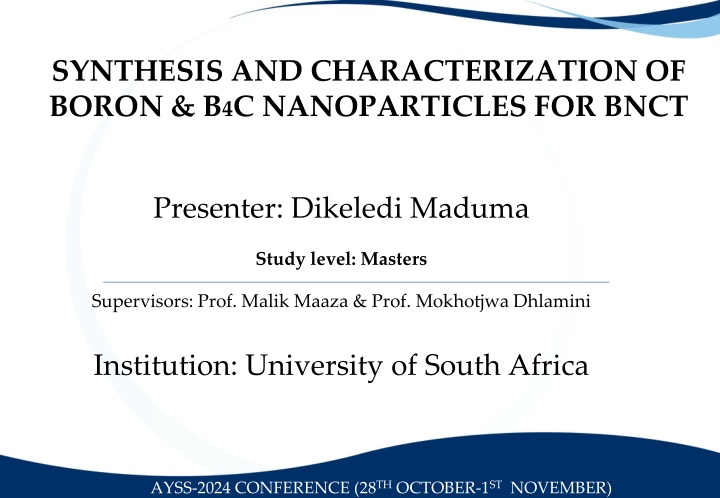
Boron and B4C Nanoparticles Synthesis for BNCT Study
"Explore the synthesis and characterization of Boron and B4C nanoparticles for Boron Neutron Capture Therapy (BNCT) in cancer treatment. Discover the method using PLAL technique, physical properties, and results of the study."
Download Presentation

Please find below an Image/Link to download the presentation.
The content on the website is provided AS IS for your information and personal use only. It may not be sold, licensed, or shared on other websites without obtaining consent from the author. If you encounter any issues during the download, it is possible that the publisher has removed the file from their server.
You are allowed to download the files provided on this website for personal or commercial use, subject to the condition that they are used lawfully. All files are the property of their respective owners.
The content on the website is provided AS IS for your information and personal use only. It may not be sold, licensed, or shared on other websites without obtaining consent from the author.
E N D
Presentation Transcript
SYNTHESIS AND CHARACTERIZATION OF BORON & B4C NANOPARTICLES FOR BNCT Presenter: Dikeledi Maduma Study level: Masters Supervisors: Prof. Malik Maaza & Prof. Mokhotjwa Dhlamini Institution: University of South Africa AYSS-2024 CONFERENCE (28THOCTOBER-1STNOVEMBER)
OUTLINE I. Introduction 2. Background on BNCT 3. Aim of Study 4. Synthesis of the Nanoparticles 5. Results 6. Conclusion 7. Future Directions 8. Acknowledgement
INTRODUCTION Our study focuses on the synthesis of Boron-carbide NPs using the PLAL technique for BNCT. The physical and chemical properties of Boron and B4C were found to be dependent on its size and morphology. Why Boron? - distinct functional and structural properties - non-toxicity - Present as trace amounts in plants and in human blood - Natural abundance isotopes:10B at 20% and11B at 80% BNCT is a cancer treatment that uses a binary system which combines the characteristics of biological targeting therapy and radiation therapy.
BACKGROUND (BNCT) is based on nuclear capture and fission reactions [1]. Neutron capture occurs when 10B is irradiated by low-energy thermal neutrons or high-energy epithermal neutrons, resulting in a fission reaction. 1. Cheng et al. 29(10), 7868 7886 (2022).
AIM OF STUDY To synthesize Boron and B4C nanoparticles using PLAL technique. To determine the shape, size and composition of the nanoparticles.
METHODS The Pulsed Laser Ablation in Liquid (PLAL) method was done with Nd:YAG laser at = 1064nm, focused onto a bulk targets immersed in a (water + 0.1% PVA) solution. The polymer PVA, was used as a dispersant. M. F. A. AliasA.S. Abd Alsada 2114(1):012089
RESULTS (B4C Morphology) Average ~ 95 nm Quasi spherical shaped
RESULTS CONT B4C nanoparticles suspended in liquid were synthesized with the use of PLAL for the application of BNCT. Different characterization techniques were used. The morphology analysis was done using TEM. EDS study was done to confirm the elements present in the particles obtained. Raman spectrum of the B4C colloid nanoparticles generated after 2hrs ablation.
FUTURE DIRECTIONS To assess cytotoxicity of the nanoparticles. Assess the stability of the nanoparticles overtime Check the uptake of boron carbide by tumor cells by an invitro study using cultured cells. Analyze the cells received [energy] of neutrons and livability.
CONCLUSION Boron carbide nanoparticles were successfully synthesized using PLAL. The characterization techniques used confirmed successful synthesis of the B4C nanoparticles. Invitro studies shall be carried out to analyze the uptake of boron by cancer cells.
ACKNOWLEDGEMENT Prof. M. Moodley (UKZN) Colleagues: T. Fakude and M. Aligholomi
THANK YOU FOR YOUR ATTENTION






















